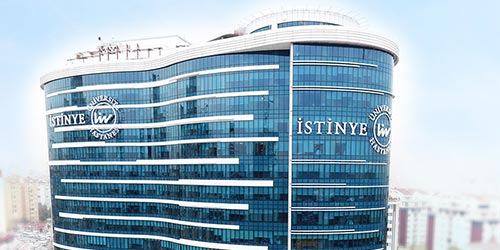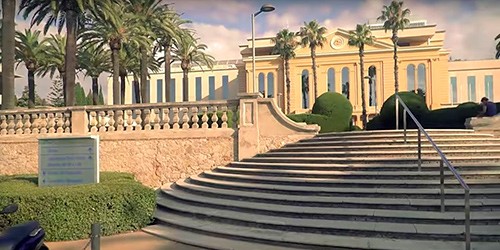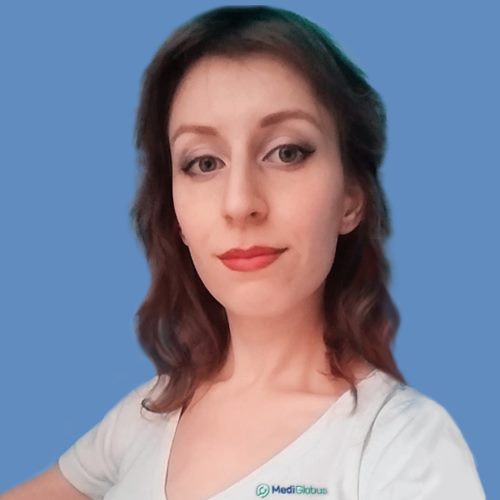1. What is DBS? |
2. What are the indications for DBS? |
3. Effectiveness of DBS for epilepsy |
4. Comparison with other treatments |
5. Patient testimonial |
6. Prices and clinics |
More than 60 million people worldwide suffer from epilepsy – a neurological disorder whose main symptom is seizures with short-term loss of body control and convulsions. Nearly 40 per cent fail to achieve sufficient control of the disease with medication and end up looking for more radical treatments. One of them – deep brain stimulation – will be discussed in this article.
Listen to the article:
What is deep brain stimulation and how does it work for epilepsy?
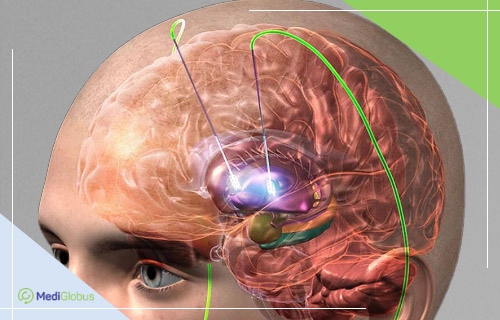
Deep brain stimulation (DBS) is an implantable device, similar to a pacemaker, that affects the electronic impulses of the brain. It is used to treat many neurological disorders, including epilepsy – a condition caused by abnormal electrical activity of neurons in the brain.
The DBS is placed under the patient’s collarbone during surgery. A connected electrode through which the required electrical impulse will be delivered is placed inside the brain. This surgery is considered safe and usually lasts 3-4 hours. In most medical centres, the patient remains conscious during the procedure.
After the surgery, the doctor will adjust the deep brain stimulation device to the individual electrical activity of the patient’s brain. It will deliver an electrical impulse at a programmed frequency that regulates the activity of neural networks. This is the most crucial part of the treatment, as it will determine the effectiveness of DBS. A big advantage compared to other treatment methods is the possibility of readjusting the device if the results are not sufficient or if the patient is concerned about side effects.
Deep Brain Stimulation is approved for the treatment of epilepsy in Europe (CE-Mark), the USA (FDA), Australia, Canada and other countries.
In addition, modern DBS machines can store information about seizures, which will be useful for the treating physician to know. Researchers involved in the development of this technology believe that DBS devices will soon be able to anticipate an impending seizure and warn the patient about it.
Depending on the model, the device can last from 3 to 9 years. After that time, surgery will be needed to replace or recharge the device’s battery.
How do I know if DBS is right for me?
International medical organisations recommend deep brain stimulation for:
patients who have failed to achieve control of their epilepsy symptoms after taking at least two different anticonvulsant medications;
patients with multifocal epilepsy;
patients who have had 6 or more seizures per month for at least the last three months (with no more than 30 days between seizures).
Epilepsy patients who fall under any of these criteria can contact their doctor to discuss treatment options. Deep brain stimulation is only one of them – VNS therapy, RNS therapy, surgical treatment, and stereotactic radiosurgery are also available for this condition. To understand which treatment option is best for the patient, a thorough diagnosis is necessary.
Studies that are prescribed to patients usually include EEG monitoring, brain MRI scans, and evaluation by a cognitive neuropsychologist. Additional tests may be ordered depending on the situation.
In choosing the most effective epilepsy treatment, the potential benefits and harms of each method are compared. In the case of DBS, side effects occur in an average of 7% of patients. The most common among them are paresthesias (tingling sensation), pain at the implant site, infections and bleeding (according to a large meta-study published in 2019 in Frontiers in Neurology). In the long term, patients may also complain of memory and emotional disturbances.
Consult an epileptologist
An online consultation with an epileptologist is an opportunity to talk to an experienced specialist beforehand and get advice on the best course of treatment. Click the button below, fill out the request form, and our coordinating physicians will help you with your decision.
What effect should be expected in the treatment of epilepsy?
The actual effect of deep brain stimulation for epilepsy is difficult to predict. The outcome depends significantly on how the procedure is carried out – the medical team individually selects the area of the brain to be electrically stimulated and adjusts the device in each case. The doctor’s approach depends on the experience of the neurosurgeon and can vary from clinic to clinic. This is why choosing the right hospital for epilepsy treatment is so important.
With rare exceptions, epilepsy cannot be cured completely. However, DBS can meaningfully reduce the frequency of seizures and make the patient less reliant on anticonvulsant medications, which significantly improves the quality of life.
It is important to understand that the effect of this procedure will not come immediately – the frequency of seizures will gradually decrease over the next 2-5 years.
According to Dr. Robert Fisher, director of the Epilepsy Center at Stanford University, between 40% and 75% of patients manage to reduce the frequency of epi-seizures by undergoing deep brain stimulation.
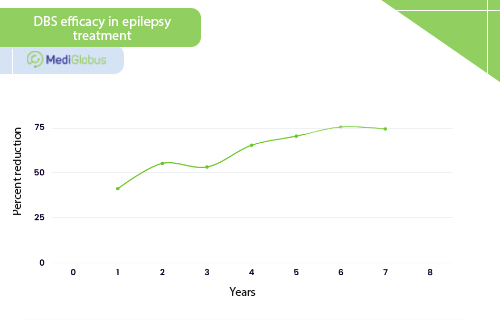
Comparison of DBS with other epilepsy treatments
When comparing different treatments for pharmacoresistant epilepsy, it is not possible to say definitively that any particular treatment is better than others. Different treatments are better for different forms of the disease, and it is up to the medical team to find the right one.
The main advantage of DBS over surgery is the ability to treat multifocal epilepsy (a form of disease in which there is no single source of abnormal electrical activity). Another benefit of this method is its reversibility – in case of side effects, the device can be reprogrammed or removed; while the excised part of the brain cannot be returned.
The team from Beijing Capital Medical University was the first to compare different epilepsy treatments within a single medical centre. They found that DBS was better suited to patients with focal generalised seizures who had undergone craniotomy and had had epilepsy for a longer period.
A comparison of the main alternatives to surgical treatment of pharmacoresistant epilepsy is presented below:
| Criteria | DBS | VNS | RNS |
|---|---|---|---|
| For which patients is it used? | Predominantly adult patients with both generalised and focal epilepsy | Adults and children with both generalised and focal epilepsy | Predominantly adults with 1-2 foci of focal epilepsy |
| Where is the electrode placed? | Thalamus | In the neck region | The location of the electrode may vary |
| Where is the device placed? | Subclavian region | Subclavian region | In the cranial region |
| Ease of use | +++ | +++ | + |
| Battery life | ++ | ++ | + |
| Side effects | — | – | – |
| Compatibility with MRI | + | + | – |
EPILEPSY TREATMENT ABROAD
Physician-coordinators of MediGlobus, an international medical tourism platform, can advise you free of charge on epilepsy treatment abroad and provide assistance in its organisation: choosing a clinic, arranging a consultation with a doctor, collecting documents, and solving other organisational issues. To make an appointment, simply click on the button below, fill out the form and wait for a call from our coordinators.
Can epilepsy be treated with DBS therapy in children? Patient’s story
Although DBS is not contraindicated in children, in most cases doctors favour VNS therapy (vagus nerve simulation). It performs well on paediatric patients and usually causes fewer side effects.
One exception to this rule is a 10-year-old boy from the US, Rylan Moll. The child began suffering from epilepsies at the age of 7 – the disease first manifested exactly on New Year’s Eve. The illness started unexpectedly and was severe – Rylan could experience up to 4 seizures in 24 hours for no apparent reason. Visualisation scans carried out in the emergency department also failed to reveal anything concrete.
The medication therapy that was immediately prescribed to the boy was not effective enough – the drugs helped for a few months and then the seizures returned. Because of constant absences from school, the boy began to fall behind academically, not to mention missing out on essential socialising with other children.
Rylan’s unique circumstances made him an ideal candidate for deep brain stimulation, despite his young age. Under MRI guidance, the surgeon fitted the boy with a DBS machine – with an electrode in the thalamus (an area of the brain) and a battery-powered generator under his ribs.
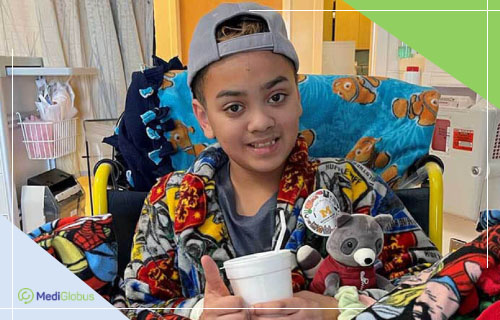
Thanks to this procedure, doctors were able to reduce Rayan’s episodes from several a day to once every 4-6 weeks. The boy was able to return to school. He spends a lot of time with friends, plays tennis, Lego and Fortnite, and is generally able to lead a normal and fulfilling life again.
What is the price of deep brain stimulation abroad? Where can patients turn for help?
Most often, adults and children with epilepsy choose clinics in Turkey, Spain, Israel and South Korea for treatment. The criteria for selection can be different, but most often preference is given to medical centres with extensive experience in performing DBS for epilepsy and good value for money.
Among Turkish clinics, we can first of all recommend the Medicana Clinic. Professor Hakan Şimşek, a neurosurgeon with 25 years of experience, sees patients here. He underwent training, with a strong emphasis on the treatment of epilepsy, at the world-famous Johns Hopkins University Hospital. The price of DBS performed by this doctor starts from $27,000. Also among Turkish specialists, Prof Selçuk Peker (Koç Uniclinik) and Ali Zirh (Medipol Clinic) have achieved great success in treatment. Their treatment costs from $43,000 and $32,000 respectively. Patients also often go to Liv Istinye Clinic, where Dr. Baran Yilmaz performs DBS for epilepsy. The price of the procedure performed by him will start at $20,000.
One of the best epilepsy clinics in Spain is the Teknon University Hospital. Their Epileptology Centre has been operating for over 30 years and has been awarded the title of “Level 4 Centre” by the National Association of Epilepsy Centres (NAEC). The department is headed by some of Spain’s most renowned neurosurgeons, Professors Antonio Roussi (President of the Spanish Epilepsy League) and Bartolomé Oliver (who introduced Spain’s first Renishaw Neuromate robot for epilepsy surgery). DBS in this hospital costs from €38,000.
In Israel, patients with epilepsy are most often referred to the Sheba Clinic, where Professor Sharon Hassin-Baer, the pioneer of this method in Israel, works. The price for DBS in Israel starts at $35,000.
Among Korean clinics, patients most often turn to SoonChunHyang. Here, patients are received by Dr. Hyeran Park. The price of treatment starts from $38,000.
Summary
DBS, or deep brain stimulation, is one of the techniques used in the treatment of pharmacoresistant epilepsy. It consists of implanting a device in the subclavian area that generates electrical impulses capable of regulating its neural activity.
According to data from various clinics, in 40%-75% of patients deep brain stimulation reduces the frequency of epileptic seizures. Patients usually continue to take anticonvulsant medication, but at much lower doses and with fewer side effects.
Potential side effects from deep brain stimulation are less severe and less common than after surgical treatment of epilepsy. Patients usually deal with tingling sensations, pain, infections and bleeding. Emotional disturbances and memory problems may also develop. The effects that occur with DBS are reversible; they can usually be eliminated by reprogramming the device or removing it.
Medical tourists turn to clinics in Turkey (Liv, Medicana, Koç, Medipol), Spain (Teknon), Israel (Sheba) and South Korea (SoonChunHyang) to perform DBS on patients with epilepsy. The price for this procedure starts at $20,000 and depends on the clinic and doctor who will perform the surgery.
Sign up for DBS
Leave an application on our website by clicking the button below. Our coordinating doctors will call you back on your phone number to give you a free consultation and organise your trip for treatment abroad.
Sources:
- 1. Epilepsy Foundation
- 2. National Institute of Neurological Disorders and Stroke
- 3. Deep brain stimulation targets in epilepsy: Systematic review and meta-analysis of anterior and centromedian thalamic nuclei and hippocampus
- 4. Directions of Deep Brain Stimulation for Epilepsy and Parkinson’s Disease
- 5. Frontiers of the Brain: Emory first in U.S. to treat epilepsy with deep brain stimulation since commercial approval
- 6. International League Against Epilepsy
- 7. University of Michigan: How deep brain stimulation helped a 10-year-old from having multiple seizures a day
- 8. British Journal of Surgery: Longevity of Deep Brain Stimulation Batteries at a Tertiary Neurosurgical Centre
- 9. Deep Brain Stimulation and Drug-Resistant Epilepsy: A Review of the Literature
- 10. Current Perspectives: Comparison and Selection of Current Implantable Anti-Epileptic Devices




